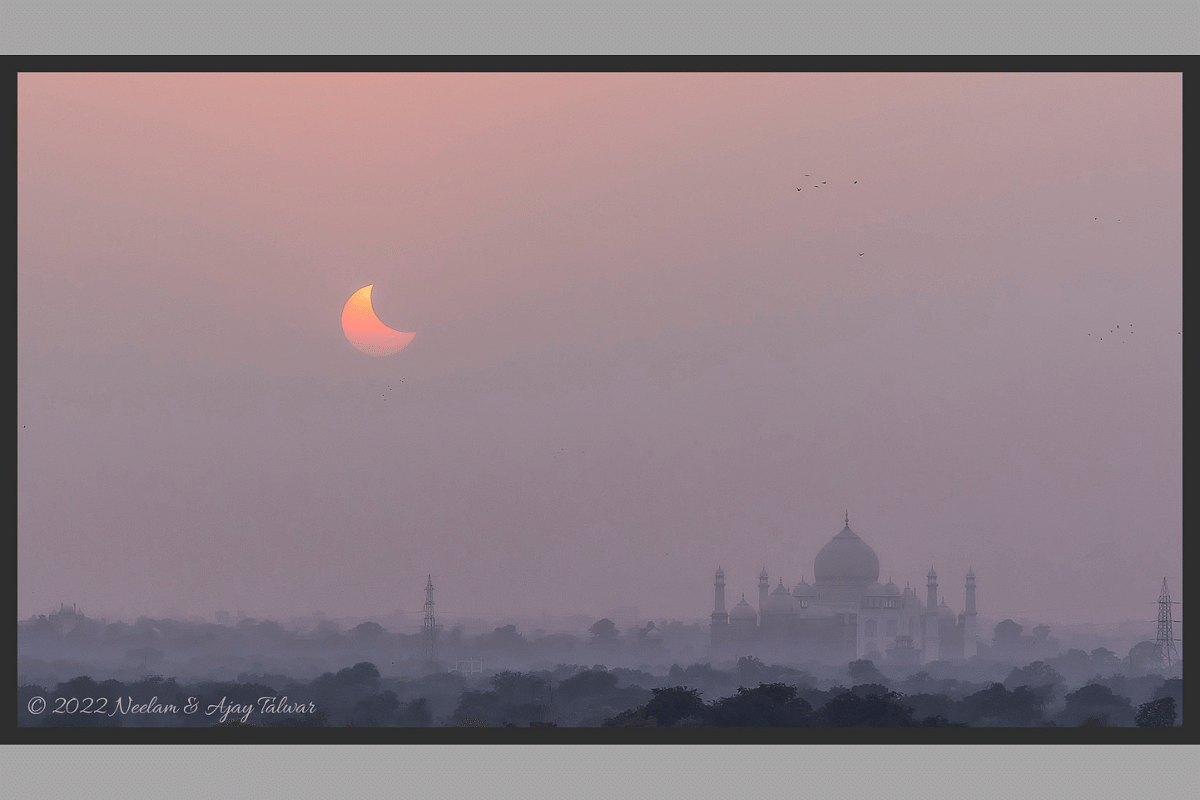Science
A Shot Of The Partial Solar Eclipse Over The Taj Mahal Is NASA Astronomy Picture Of The Day
- Today's NASA Astronomy Picture of the Day, “Sunset, Moonset, Taj Mahal,” was captured by Indian astrophotographers Neelam and Ajay Talwar.

Neelam and Ajay Talwar's capture of the partial solar eclipse over the Taj Mahal is featured on Astronomy Picture of the Day (APOD). (Photo: Neelam and Ajay Talwar)
The evening sky over the Taj Mahal is the Astronomy Picture of the Day — or “APOD,” as it’s popularly called — for 27 October.
The picture, taken by Neelam and Ajay Talwar, captures the Sun and New Moon setting together on 25 October, as seen from Agra, a city on the banks of river Yamuna that is home to the Taj Mahal.
It was the day of the partial solar eclipse in some parts of the world, including India, when the picture was taken. Which is why the Sun looks bitten into, shape-shifting into a Moon-like crescent as it slowly winds down for the day.
Calling it the “Taj Solar Eclipse,” Ajay writes about his capture: “Looks like the celestial conjunction is trying to imitate the shape of the edifice, the dome of the Taj Mahal, Agra.”
The shot was taken about 4 km from the Taj Mahal, “from top of the water tank in line with the Taj Mahal and the Solar Eclipse,” the description reads on the ‘The World At Night’ website, where it was also featured.
APOD is based upon work supported by the United States space agency National Aeronautics and Space Administration (NASA). It is a service of the Astrophysics Science Division at NASA’s Goddard Space Flight Center and Michigan Technological University.
The creators of this very popular and possibly largest archive of astronomy images on the web are professional astronomers Robert Nemiroff and Jerry Bonnell. They have kept this digital service going since 1995.
Nemiroff is a professor of physics at Michigan Technological University and Bonnell is a scientist at NASA’s Goddard Space Flight Center. Both of them were previously colleagues at NASA.
A new image is featured and spotlighted on the website every day, accompanied by a textual description by a professional astronomer.
With this simple task, APOD has hosted more than 9,900 daily images over the last 27 years. It is available in 20 languages and is seen by millions each day. It was honoured in the International Astronomical Union’s first-ever round of outreach prizes in June this year.
The picture picked for APOD on 27 October, “Sunset, Moonset, Taj Mahal,” was captured by Neelam and Ajay Talwar.
Neelam and Ajay Talwar identify as night-sky photographers. While Ajay has been at astrophotography for more than 25 years, Neelam has been an air crew with Air India since 1993 and, more recently, has been capturing the night sky mid-flights.
The 27 October APOD entry is Ajay’s second feature on APOD. His first, an image from 2015, showed the nova in Sagittarius which had briefly become visible to the naked eye. It was captured on 21 March 2015 from Ranikhet in the Himalayas.
Also Read:
Introducing ElectionsHQ + 50 Ground Reports Project
The 2024 elections might seem easy to guess, but there are some important questions that shouldn't be missed.
Do freebies still sway voters? Do people prioritise infrastructure when voting? How will Punjab vote?
The answers to these questions provide great insights into where we, as a country, are headed in the years to come.
Swarajya is starting a project with an aim to do 50 solid ground stories and a smart commentary service on WhatsApp, a one-of-a-kind. We'd love your support during this election season.
Click below to contribute.
Latest